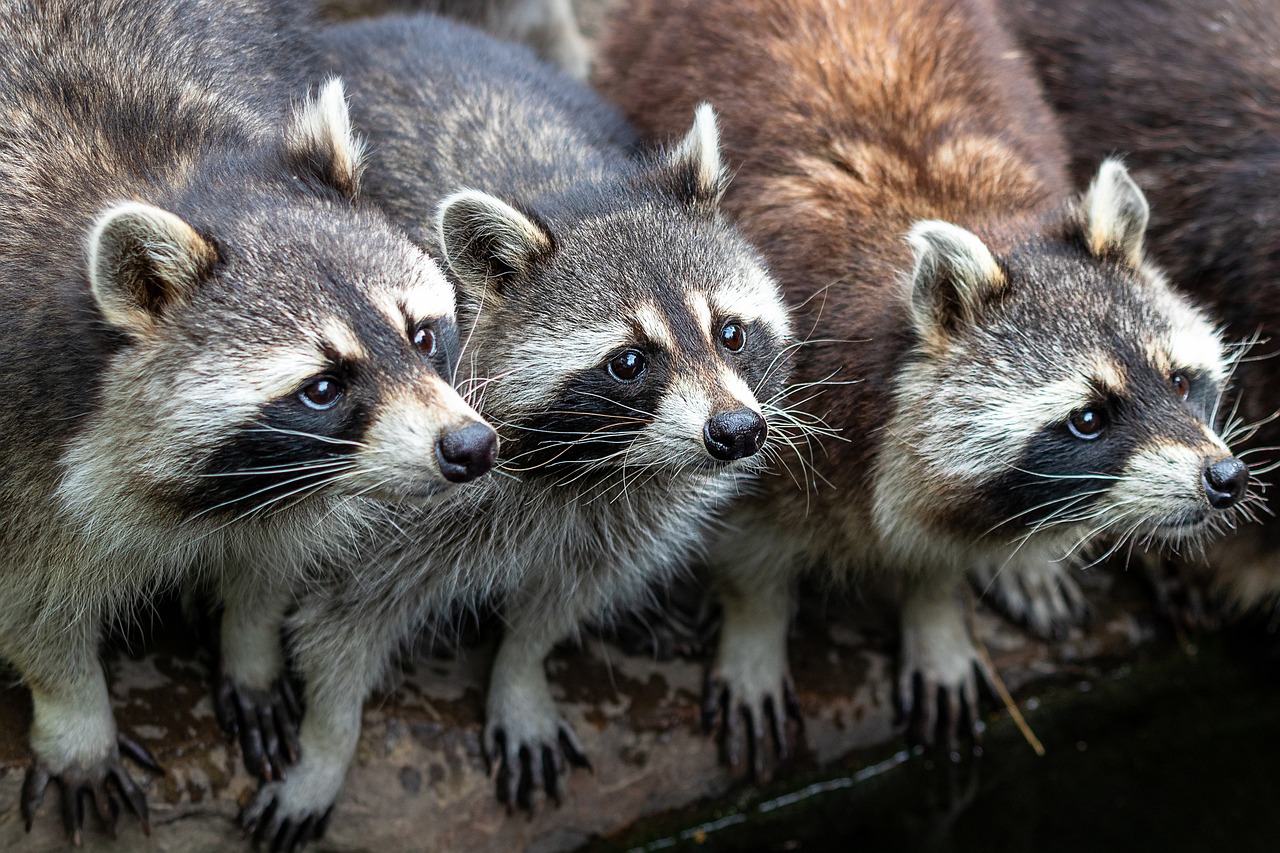One of the intriguing aspects of raccoon behavior is their social structure and living arrangements. How many raccoons live together in a group, and what factors influence their social dynamics? In this article, we’ll dive into the raccoon societies, shedding light on their group sizes, behaviors, and the factors that shape their cohabitation.
The Solitary Stereotype
Raccoons are often perceived as solitary animals, sneaking around at night in search of food, scavenging through trash cans, and exploring their surroundings. While this image isn’t entirely incorrect, it doesn’t capture the full spectrum of raccoon social behavior. Raccoons are, in fact, more social and adaptable than many people realize.
Solitary by Nature
In their early lives, raccoons are quite solitary. Mother raccoons, called sows, give birth to a litter of kits, typically consisting of two to five babies. For the first few months of their lives, these young raccoons remain with their mothers, learning essential survival skills, including foraging techniques and how to navigate their environment.
As they grow older, young raccoons start to venture out on their own, gradually becoming more independent. This transition to independence is when raccoons often begin to exhibit solitary behavior. Young raccoons will disperse from their family unit and establish their territories. This phase is characterized by individual foraging and a preference for solitude.
Surprising Social Skills
However, raccoons are not as solitary as some other wildlife species. They exhibit a surprising degree of social flexibility when circumstances permit. Let’s explore the different social structures and living arrangements raccoons can adopt.
1. The Solitary Lifestyle
As mentioned earlier, solitary living is common among adult raccoons, especially males. Solitary raccoons establish and defend their territories, which can vary in size depending on factors like the availability of resources, habitat quality, and population density. These territories typically encompass areas with abundant food sources, such as urban neighborhoods with accessible garbage cans, or natural environments with rich foraging opportunities.
In solitary raccoon territories, interactions with other raccoons are often limited to confrontations over resources or mating opportunities. Raccoons are known for their territorial behavior and can be quite aggressive when defending their turf. These territorial disputes can lead to fights and vocalizations, such as hissing and growling.
2. Bachelor Groups
While raccoons are primarily solitary animals, they sometimes form small groups known as bachelor groups. These groups typically consist of juvenile or subadult males. These males come together for a period, often during the mating season, to socialize and share resources. Bachelor groups are more commonly observed in areas with a higher population density of raccoons.
Bachelor groups provide young male raccoons with the opportunity to learn from one another and gain social experience. They can also cooperate to find food more efficiently and defend themselves against potential threats.
3. Maternal Family Units
During the early stages of a raccoon’s life, family units, or maternal groups, are common. These groups consist of a mother raccoon and her young kits. The mother is responsible for teaching her offspring essential skills, including how to find food and avoid predators.
Maternal family units are temporary, as young raccoons gradually become independent and leave to establish their territories. Nonetheless, during this phase, raccoon kits are social and rely heavily on their mother for protection and education.
4. Female Associations
Female raccoons tend to exhibit more social behavior than males. They may form loose associations with other females, particularly during the winter months when resources are scarcer. These associations are not as structured as bachelor groups and are often temporary, driven by the need to increase foraging efficiency and share warmth in colder weather.
The Size of Raccoon Groups
Now that we’ve explored the various social structures and living arrangements raccoons can adopt, let’s delve into the question at the heart of this article: how many raccoons live together in a group?
Solitary Raccoons
In areas with ample resources, such as urban environments with readily available food sources, solitary raccoons may be more prevalent. In these cases, it’s not uncommon to find individual raccoons living alone within their territories. However, the exact size of these territories can vary widely depending on factors like food availability and population density. In densely populated urban areas, a single raccoon may stake out a relatively small territory encompassing a few blocks, while in more rural settings, territories can span several square miles.
Bachelor Groups
Bachelor groups of raccoons usually consist of two to five individuals. These groups are temporary and often form during the mating season when males come together to socialize and compete for access to females. The size of bachelor groups can vary based on factors such as resource availability and population density. In areas with a high concentration of raccoons, larger bachelor groups may form, while in less populated regions, smaller groups are more common.
Maternal Family Units
Maternal family units, consisting of a mother raccoon and her kits, typically range in size from three to seven members, including the mother. The number of kits in a litter can vary, but it’s not unusual for a mother raccoon to give birth to three to five kits. These family units are temporary, as young raccoons become independent and gradually disperse from their mothers.
Female Associations
Female associations, which are less structured than bachelor groups, can include a few female raccoons coming together during times of resource scarcity or for warmth during the colder months. The size of these associations can vary but often involves just a few individuals.
Factors Influencing Group Size
Several factors influence the size and composition of raccoon groups, whether solitary, bachelor groups, maternal family units, or female associations. Here are some key factors:
1. Resource Availability
The abundance of food resources in a given area plays a significant role in determining raccoon group sizes. In areas with a plentiful supply of food, raccoons are more likely to live solitarily or in smaller groups. Conversely, in regions with limited food resources, raccoons may form larger groups to enhance their foraging efficiency.
2. Population Density
Population density is another critical factor. In areas with a high concentration of raccoons, interactions and group formations are more common. In contrast, raccoons in less densely populated areas may have larger territories and be more solitary.
3. Seasonal Variations
Seasonal changes in weather and resource availability can also influence raccoon group dynamics. For instance, during the winter months, when food is scarcer and temperatures drop, female raccoons may form loose associations to share warmth and find food more efficiently.
4. Mating Season
The mating season is a significant driver of raccoon group dynamics. During this time, males come together to compete for access to females, leading to the formation of bachelor groups. Female raccoons may also interact more frequently with males during this period.
5. Maternal Care
Maternal family units are primarily influenced by the presence of kits. A mother raccoon will care for her young until they are old enough to fend for themselves. The number of kits in a litter can vary, affecting the size of the maternal group.
6. Habitat Type
The type of habitat in which raccoons live can also impact their group size and structure. Urban environments with a consistent supply of human food waste may lead to smaller, more solitary raccoon populations, while natural habitats may encourage larger territories and less social behavior.
Communication and Social Behavior
Raccoons, despite their reputation as solitary animals, are skilled communicators and exhibit various social behaviors, even when living alone. Understanding these behaviors provides insights into the intricacies of raccoon social interactions.
Vocalizations
Raccoons communicate through a range of vocalizations, including hissing, growling, and chittering. These sounds are used in various contexts, such as territorial disputes, mating rituals, and interactions between family members.
Body Language
Raccoons also use body language to communicate. They may puff up their fur and arch their backs to appear larger when threatened or during confrontations with other raccoons. Tail positioning and ear orientation can also convey their intentions and emotions.
Scent Marking
Scent marking is a crucial aspect of raccoon communication. Raccoons have specialized scent glands on their paws and around their anus, allowing them to leave scent marks on objects and territory boundaries. These scent marks convey information about an individual’s presence, reproductive status, and dominance.
Grooming
Grooming is another social behavior among raccoons. Mutual grooming can strengthen social bonds within groups and help maintain hygiene.
The Benefits of Raccoon Groups
Why do raccoons, despite being capable of living solitarily, sometimes form groups or associations? There are several advantages to social behavior among raccoons:
1. Resource Sharing
In group settings, raccoons can share knowledge about food sources and foraging techniques, increasing their chances of finding sufficient nutrition. This is especially valuable during times of scarcity.
2. Protection
Group living provides added protection against potential threats. Raccoons can work together to defend against predators and other territorial raccoons.
3. Social Learning
Young raccoons benefit from social interactions, as they can learn essential life skills from their peers and older group members. This is particularly important during their early stages of independence.
4. Mating Opportunities
During the mating season, males in bachelor groups have a higher chance of encountering receptive females, increasing their chances of reproductive success.
5. Warmth and Comfort
In colder climates or during the winter months, forming groups or associations with other raccoons can help conserve body heat and provide a sense of security.
Recommended Products for Raccoon Enthusiasts
- Wildlife Camera for Night Vision – Capture the nocturnal activities of raccoons with this high-quality wildlife camera.
- Raccoon Proof Trash Can – Keep your trash secure and prevent raccoons from making a mess with this durable, raccoon-proof trash can.
- Raccoon Deterrent Spray – Use this spray to keep raccoons away from your property without harming them.
- Raccoon Plush Toy – A cute and cuddly raccoon plush toy for wildlife enthusiasts of all ages.
- Field Guide to North American Wildlife – Learn more about raccoons and other wildlife with this comprehensive field guide.
By purchasing through these links, you support our efforts to provide valuable wildlife content. Thank you!
Conclusion
Raccoons are far more socially adaptable than their solitary reputation suggests. While they do exhibit solitary behavior, they can also form various types of groups, ranging from bachelor groups to maternal family units and female associations. The size and composition of these groups depend on factors such as resource availability, population density, seasonal changes, and habitat type.
Understanding raccoon social behavior not only enriches our knowledge of these fascinating creatures but also highlights the importance of preserving their habitats and natural environments. As urbanization continues to encroach on raccoon habitats, it becomes increasingly crucial to find ways to coexist with these resourceful and adaptable animals.
So, the next time you spot a raccoon digging through your trash or making its way through your neighborhood, remember that behind their masked faces and nimble paws lies a complex world of social interactions and adaptations that make them one of the most intriguing creatures in the animal kingdom.










